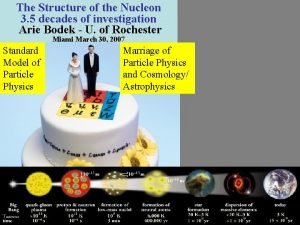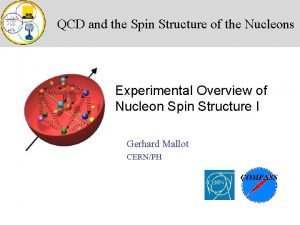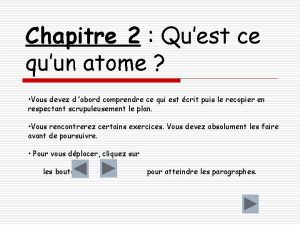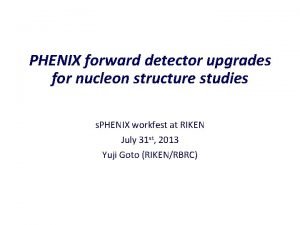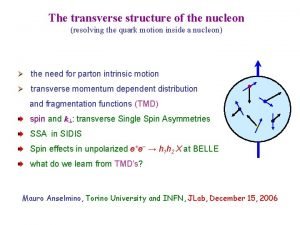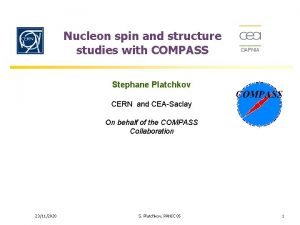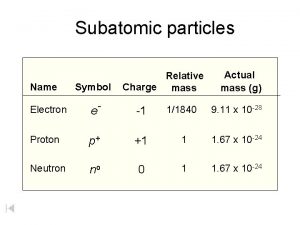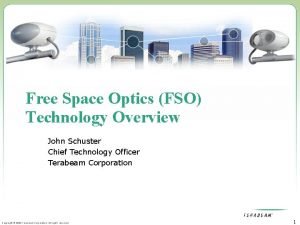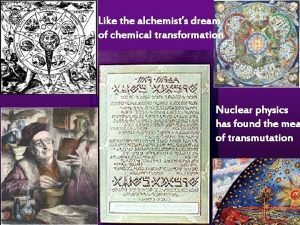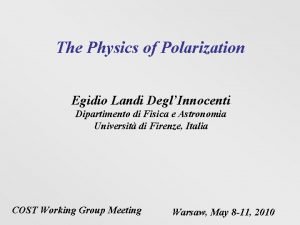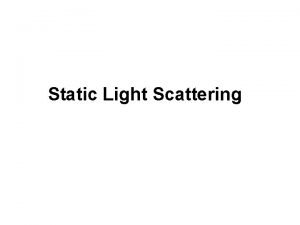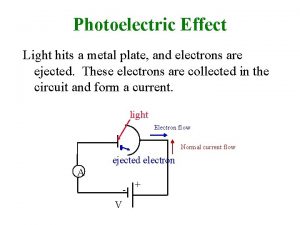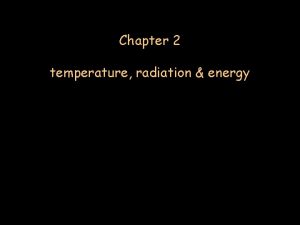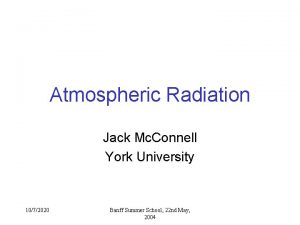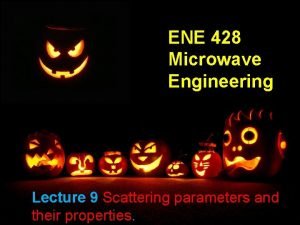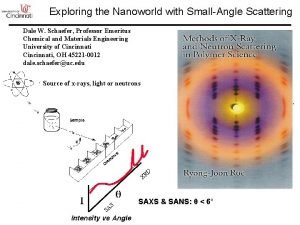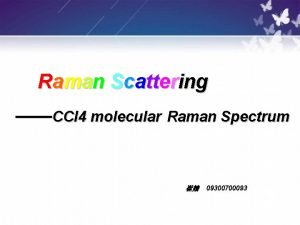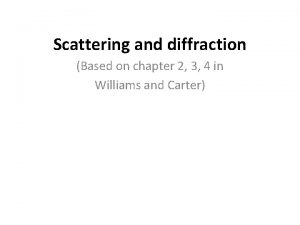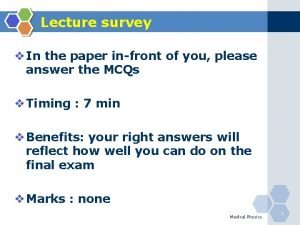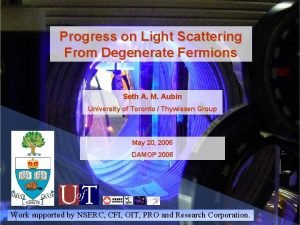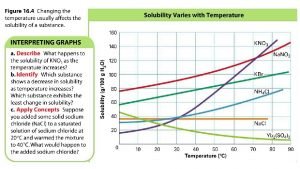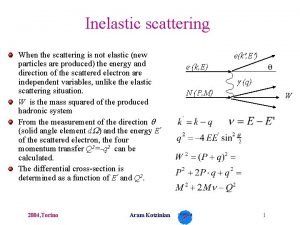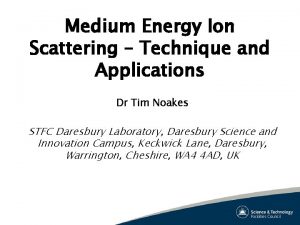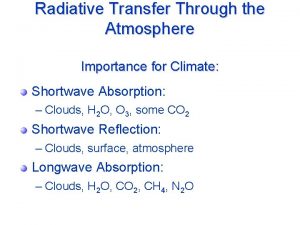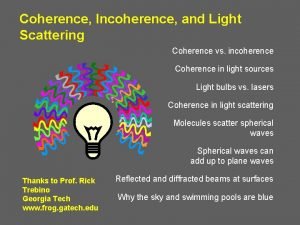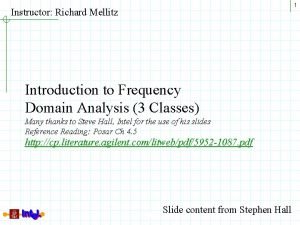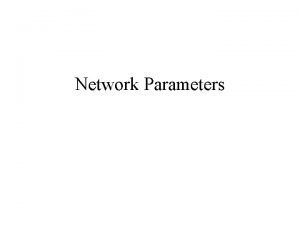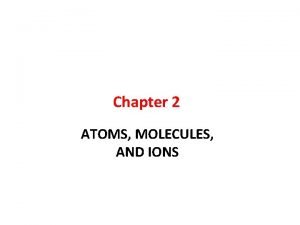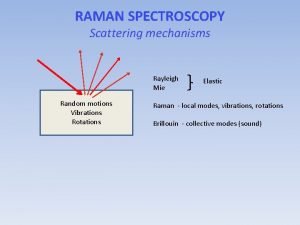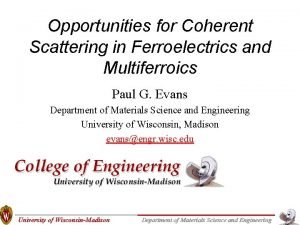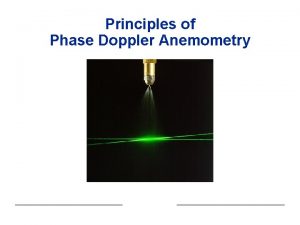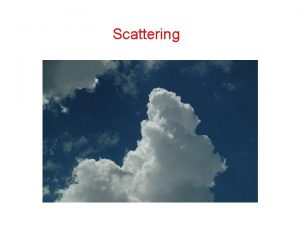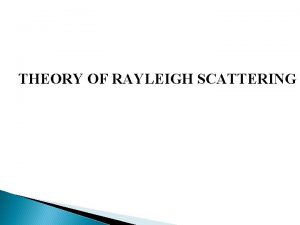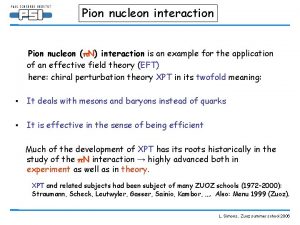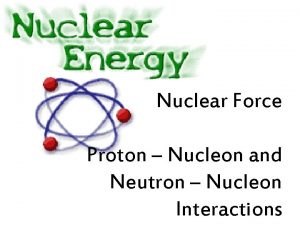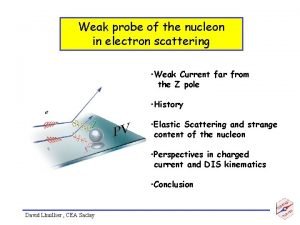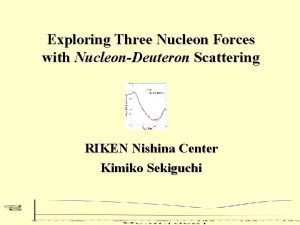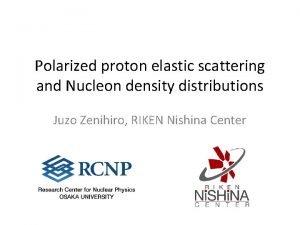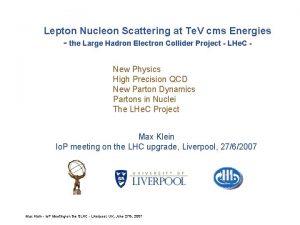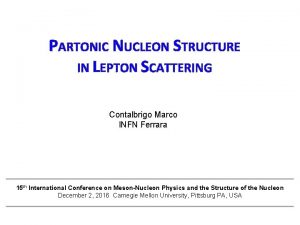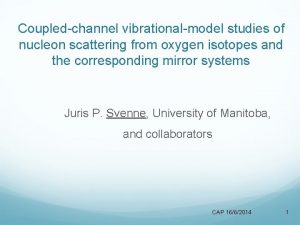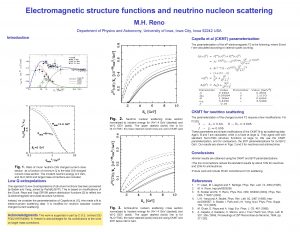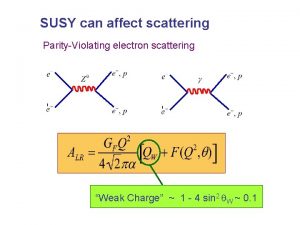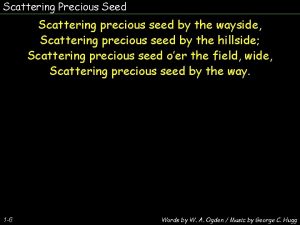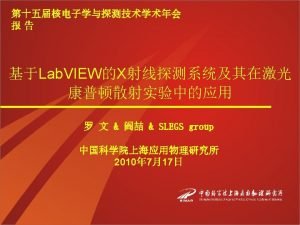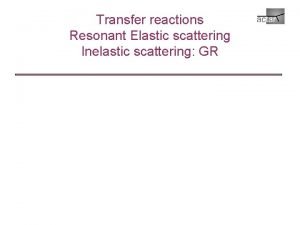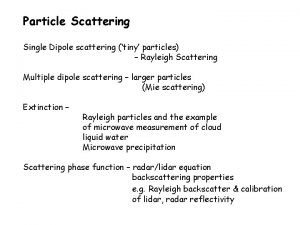Nucleon Scattering I I 3 d d d



































- Slides: 35

Nucleon Scattering | I, I 3 +d d d 0 d | 1, 1 | 1, -1 | 1 0 If the strong interaction is I 3 -invariant These reactions must occur with equal strengths…equal probabilities… equal CROSS SECTIONS involve identical matrix elements

Now consider these (possible and observed) collisions | 1, 1 > p + p d + + < 1, 1 | (|1, 0 + |1, 1 ) p + n d + 0 < 1, 0 | | 1, -1 > n + n d + < 1, -1 | <pp|L|d +> : <pn|L|d 0> : <nn|L|d -> 1 : 1/ 2 : 1 Then the ratio of cross sections: spp d : spn d : snn d + 0 : = 2: 1: 2

Consider the scattering reactions: +p n n p p The strong force does not discriminate between nucleon or pion charge. What can we expect for the cross section of these three reactions?

If we enforce conservation of isospin we can only connect initial and final states of the same total I, I 3 +p | I, I 3 > 1 ½ n n -1 -½ But | 3/2, 3/2 > | 3/2, -3/2 > -1 -½ + p -1 ½ means combining: | 1 -1 > | 1/2, 1/2 > = |3/2, -1/2 > - |1/2, -1/2 > ) this interaction involves two matrix elements < -p|L| -p> = M + M

+ + p a. 1, 1 ½ , ½ b. + p 1, -1 elastic scattering ½ , ½ but only one of the above can also participate in a c. ? + p 0? + n charge exchange 1, -1 ½ , ½ 1, 0 ½ , -½ process This IS observed! So all strong interactions not SIMPLY charge independent. I 3 ISOSPIN independence is more general.

+ + p a. 1, 1 ½ , ½ +p b. 1, -1 +½p , ½ c. + p 0 + n 1, -1 ½ , ½ 1, 0 ½, ½ elastic scattering charge exchange process These three interactions involve the ISOSPIN spaces: + p Recall: p 1 3 2 3 0 n 2 3 + 1 3 2 2 Mfi M½ Let’s denote: M 3/2 = same by I 3 -indep.

+ + p a. b. + p c. + p 0 + n + p p 0 n elastic scattering charge exchange process M½ 1 3 2 3 + 1 3 2 M a. a 3/2 1 M + 2 M |2 | b. b 3 3/2 3 1/2 2 c. c | 3 M 3/2 - 3 M 1/2| M 3/2

+ + + p a. b. + p c. + p 0 + n a : b : c = 2 M 3/2 : a M 3/22 b | 13 M 3/2 + 23 M 1/2|2 2 c | 3 M 3/2 - 3 M 1/2| |M 3/2 +2 M 1/2|2: 29|M 3/2 - M 1/2|2 1 9 for the combined cross section of both processes Now if M 3/2=M 1/2 then +p = -total p but also -p 0 n= 0

2 H beam S 1 target S 2 S 3 S 4 Measured the depletion of pion beam repeated with the tank full, empty repeated with + and - beam for KE 195 Me. V (the resonance of the 3/2 -spin ) 200 180 + + p 160 140 120 100 Total Cross Section s. T (10 -27 cm 2) 80 60 40 20 0 + p 40 100 200 400 Lab Energy of Pion Beam (Me. V)

a : b : c = a : b + c = 2 M 3/2 : |M 3/2 +2 M 1/2|2: 29|M 3/2 - M 1/2|2 1 9 a : b : c = 9 : 1 : 2

Symmetry implies any transformation still satisfies the same Schrödinger equation, same Hamiltonian: (U ) U† U means we must demand: U†H U= H [H , U]= 0 Which means that the operator U must be associated with a CONSERVED quantity! Though U are UNITARY, not necessarily HERMITIAN, but remember: where the G is Hermitian! since you’ve already shown [H , U]= 0 [H , G]= 0 The GENERATOR of any SYMMETRY OPERATION is an OPERATOR of a CONSERVED OBSERVABLE (quantum number!)

Mesons Particle pion eta rho omega isospin I 3 +1 0 -1 0 mass Me. V/c 2 139. 569 134. 964 139. 569 548. 8 770. 783. 0 Spin-0 charge states + 0 - 0 + 0 0 Baryons Q +1 0 -1 0 Spin-1/2 nucleon delta +1/2 -1/2 +3/2 +1/2 -3/2 938. 280 939. 573 1232. p n +1 0 ++ + 0 - +2 +1 0 -1 Spin-3/2

Q = I 3 + ½Y “hypercharge” or BARYON NUMBER because =1 for baryons 0 for mesons

1947 Rochester and Butler cloud chamber cosmic ray event of a neutral object decaying into two pions K 0 + +

1947 Rochester and Butler cloud chamber cosmic ray event of a neutral object decaying into two pions K 0 + + m = 497. 72 Me. V 1949 C. F. Powell photographic emulsion event K + + + m = 493. 67 Me. V

- 1950 Carl Anderson (Cal Tech) p+ - p m =1115. 6 Me. V mp=938. 27 Me. V

1952 Brookhaven Cosmotron 1 st modern accelerator artificially creating these particles for study 1954 6. 2 -Ge. V p synchrotron Lawrence, Berkeley 1960 28 -Ge. V p synchrotron 33 -Ge. V p synchrotron CERN, Geneva Brookhaven Lab 1962 6 -Ge. V e synchrotron Cambridge 1963 12. 5 -Ge. V p synchrotron 1964 6. 5 -Ge. V p synchrotron 1966 21 -Ge. V e Linac Argonne Lab DESY, Germany SLAC (Standford)

Particle isospin I 3 +1/2 -1/2 139. 569 134. 964 139. 569 493. 67 497. 72 + 0 K+ K 0 +1 0 -1 +1 0 +1/2 -1/2 497. 72 493. 67 K 0 K- 0 -1 0 +1 0 -1 548. 8 770. 0 + 0 - 0 +1 0 -1 0 783. 0 0 0 pion +1 0 -1 kaon eta rho omega Spin-0 Pseudoscalar Mesons mass charge Me. V/c 2 states Q Spin-1/2 Baryons nucleon lambda Sigma Cascade +1/2 -1/2 0 +1 0 -1 +1/2 -1/2 938. 280 939. 573 1115. 6 p n +1 0 0 1385. + 0 + - +1 0 -1 +1 -1 1533.

Spin-3/2 Baryons Particle Delta Sigma-star isospin I 3 mass Me. V/c 2 charge states Q +3/2 +1/2 -3/2 1232. ++ + 0 - +2 +1 0 -1 1385. + 0 - +1 0 -1 1533. *+ *- +1 -1 Cascade-star +1/2 -1/2







pdg. lbl. gov/pdgmail

FRANK & EARNEST

These new heavier particle states were produced as copiously as s in nuclear collisions (and in fact decay into s) all evidence of STRONG INTERACTIONS but unlike STRONG production/decay phenomena like nuclear resonances (all with final decay products, like the D) which decay “instantly”, i. e. , as readily as they are produced or ELECTROMAGNETIC production/decay phenomena atomic (electron) resonances (all with decay) these new states decayed slowly like the weak decays p n + e + m+ which decay via neutrinos (accepted as the “signature” of a weak decay)

What else was about them? Observed NEVER Observed + p+ K+ + S K 0 + S 0 K 0 + L + p+ + + S K 0 + n 0 + L all still conserve mass, charge, isospin “Associated production” Also NEVER observe: + p+ K + S+ but DO see: + + p + K+ + S +

1952 -53 (Pais, Gell-man) “Strangeness” K+ K 0 KK 0 + 0 - +1 +1 -1 -1 -1 Q = I 3 + ½Y Y B+S

Particle isospin I 3 +1/2 -1/2 139. 569 134. 964 139. 569 493. 67 497. 72 + 0 K+ K 0 +1 0 -1 +1 0 +1/2 -1/2 497. 72 493. 67 K 0 K- 0 -1 0 +1 0 -1 548. 8 770. 0 + 0 - 0 +1 0 -1 0 783. 0 0 0 pion +1 0 -1 kaon eta rho omega Spin-0 Pseudoscalar Mesons mass charge Me. V/c 2 states Q Strangeness S 0 0 0 +1 +1 1 1 0 0 0 Spin-1/2 Baryons nucleon lambda Sigma Cascade +1/2 -1/2 0 +1 0 -1 +1/2 -1/2 938. 280 939. 573 1115. 6 p n +1 0 0 1385. + 0 + - +1 0 -1 +1 -1 1533. 0 0 1 1 2 2

SU(2) Combining SPIN or ISOSPIN ½ objects gives new states described by the DIRECT PRODUCT REPRESENTATION built from two 2 -dim irreducible representations: one 2(½)+1 and another 2(½)+1 yielding a 4 -dim space. ispin=1 triplet +½ isospin space -½ = = which we noted reduces to 2 2 = 1 3 the isospin 0 singlet state 1 ( 2 - )

SU(2)- Spin added a new variable to the parameter space defining all state functions - it introduced a degeneracy to the states already identified; each eigenstate n became associated with a 2 +1 multiplet of additional states - the new eigenvalues were integers, restricted to a range (- to + ) and separated in integral steps - only one of its 3 operators, J 3, was diagonal, giving distinct eigenvalues. The remaining operators, J 1 and J 2, actually mixed states. - however, a pair of ladder operators could constructed: J+= J 1 + i. J 2 and J-= J 1 - i. J 2 which stepped between eigenstates of a given multiplet. -1/2 +1/2 -1 0 1

The SU(3) Generators are Gi = ½ i just like the Gi = ½ i are for SU(2) The ½ distinguishes UNITARY from ORTHOGONAL operators. i appear in the SU(2) subspaces in block diagonal 3’s diagonal entries form. are just the eigenvalues of the isospin projection. 8 is ALSO diagonal! It’s eigenvalues must represent a NEW QUANTUM number! Notice, like hypercharge (a linear combination of conserved quantities), 8 is a linear combinations of 2 diagonal matrices: 2 SU(2) subspaces.

The remaining matrices MIX states. In exactly the same way you found the complete multiplets representing angular momentum/spin, we can define T± G 1± i. G 2 U± G 6± i. G 7 V± G 4± i. G 5 T±, T 3 are isospin operators By slightly redefining our variables we can associate the eigenvalues of 8 with HYPERCHARGE.
 Nucleon
Nucleon Qcd
Qcd Couche electronique
Couche electronique Nucleon
Nucleon Nucleon
Nucleon Nucleon
Nucleon Symbol for subatomic particles
Symbol for subatomic particles Free space optics
Free space optics Pemantulan dan pembiasan gelombang elektromagnetik
Pemantulan dan pembiasan gelombang elektromagnetik Sezione d'urto thomson
Sezione d'urto thomson Scattering reaction
Scattering reaction Scattering matrix
Scattering matrix Scattering cross section in nuclear physics
Scattering cross section in nuclear physics Zimm plot excel
Zimm plot excel Photoelectric effect สรุป
Photoelectric effect สรุป Light scattering
Light scattering Mie plot
Mie plot Scattering efficiency
Scattering efficiency Reciprocal network
Reciprocal network Rayleigh scattering
Rayleigh scattering Small angle scattering
Small angle scattering Raman scattering definition
Raman scattering definition Diffraction and scattering
Diffraction and scattering Compton scattering vs photoelectric effect
Compton scattering vs photoelectric effect Pauli blocking of light scattering in degenerate fermions
Pauli blocking of light scattering in degenerate fermions Scattering of light in suspension
Scattering of light in suspension Non elastic scattering
Non elastic scattering Elastic energy
Elastic energy Rayleigh scattering
Rayleigh scattering Scattering of light
Scattering of light Scattering matrix
Scattering matrix Abcd short
Abcd short Rutherford scattering
Rutherford scattering Rayleigh vs raman scattering
Rayleigh vs raman scattering Coherent scattering
Coherent scattering Light scattering
Light scattering
